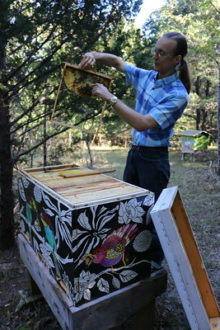Nearly 70 percent of all flowering plants depend on bees and other pollinators to reproduce; the fruits and seeds from those plants constitute more than 30 percent of our food and drink, according to The Xerces Society.
Dr. Leo Sharashkin, a beekeeper in Ava, Missouri, says farmers become discouraged from adding bees to their operations due to bee stock issues, costly beekeeping equipment, and complicated management methods.
“Honeybees are extremely beneficial on any farm as pollinators and as producers of honey and wax. The increased production of agricultural crops due to honeybee pollination is estimated at $19 billion (2010),” explained Sharashkin. “But with only 2.6 million beehives in the US—down from 6 million in the 1940s—up to 70% of honey consumed in the US is imported. Why is not beekeeping more widespread?”
Sharashkin maintains a stationary apiary with more than three dozen hives. He says the apiary was conceived as a model for demonstrating how honeybees could be kept using natural, low-input methods (no drugs, no sugar, no swarm control), with local stock obtained from the wild.
In 2015, he applied for and received a $7,469 NCR-SARE Farmer Rancher grant to develop and share his solution to starting an apiary based on catching and propagating local bee stock, using bee-friendly, do-it-yourself hive models, and simple, accessible management techniques.
In association with his grant, he posted free information on their website www.horizontalhive.com about catching local swarms and building inexpensive equipment such as swarm traps and horizontal hives. He also published a guide to managing horizontal hives.
“How sought-after this information is can be judged by the following fact: the size of our mailing list at the beginning of the project was under 1,000 subscribers,” said Sharashkin. “In less than two years it increased by more than five times and now represents over 5,000 subscribers from all over the U.S. and even internationally.”
For more information on Sharashkin’s NCR-SARE Farmer Rancher grant project, visit the SARE project reporting website or contact the NCR-SARE office.
Dig Deeper
View a video of Leo Sharashkin's presentation on this project.
